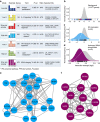Combinatorial code governing cellular responses to complex stimuli
- PMID: 25896517
- PMCID: PMC4410637
- DOI: 10.1038/ncomms7847
Combinatorial code governing cellular responses to complex stimuli
Abstract
Cells adapt to their environment through the integration of complex signals. Multiple signals can induce synergistic or antagonistic interactions, currently considered as homogenous behaviours. Here, we use a systematic theoretical approach to enumerate the possible interaction profiles for outputs measured in the conditions 0 (control), signals X, Y, X+Y. Combinatorial analysis reveals 82 possible interaction profiles, which we biologically and mathematically grouped into five positive and five negative interaction modes. To experimentally validate their use in living cells, we apply an original computational workflow to transcriptomics data of innate immune cells integrating physiopathological signal combinations. Up to 9 of the 10 defined modes coexisted in context-dependent proportions. Each interaction mode was preferentially used in specific biological pathways, suggesting a functional role in the adaptation to multiple signals. Our work defines an exhaustive map of interaction modes for cells integrating pairs of physiopathological and pharmacological stimuli.
Figures





References
-
- Edwards J. S., Ibarra R. U. & Palsson B. O. In silico predictions of Escherichia coli metabolic capabilities are consistent with experimental data. Nat. Biotechnol. 19, 125–130 (2001). - PubMed
-
- Prost L. R. et al.. Activation of the bacterial sensor kinase PhoQ by acidic pH. Mol. Cell 26, 165–174 (2007). - PubMed
Publication types
MeSH terms
Grants and funding
LinkOut - more resources
Full Text Sources
Other Literature Sources
Molecular Biology Databases

